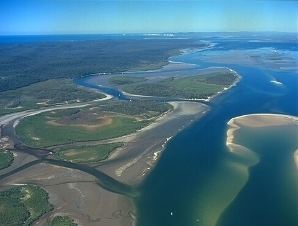 | ||
R marine jones great sandy straits experience 2015
The Great Sandy Strait is a 70 km Australian sand passage estuary separating mainland Queensland, from World Heritage listed Fraser Island.
Contents
- R marine jones great sandy straits experience 2015
- Map of Great Sandy Strait Queensland Australia
- Great sandy strait
- Description
- Environment
- Birds
- References
Map of Great Sandy Strait, Queensland, Australia
Great sandy strait
Description
The strait extends north from Tin Can Bay to Hervey Bay. The Mary River enters the strait at River Heads. It covers an area of 932 km2. Tourism and commercial fishing are the two main industries that are active within the Strait. Boating and fishing are also pursued for recreation. Each year in June the Bay to Bay yacht race is sailed on the Great Sandy Strait.
Environment
A complex landscape of mangroves, sandbanks, intertidal sand, mud islands, salt marshes and seagrass beds, the Strait is an important habitat for breeding fish, crustaceans, dugongs, dolphins and marine turtles. Migrating humpback whales use the calms waters of the strait to rest for a few days between August and November. An analysis of commercial catch data in the area between 1988 and 2003 revealed a significant reduction in fish stock. The campaign against the Traveston Crossing Dam included claims the dam would have a significant environmental impact on the Great Sandy Strait. Other protected areas within or adjacent to the Strait include Great Sandy National Park, Poona National Park and Great Sandy Conservation Park.
Birds
The lower part of Great Sandy Strait was listed under the Ramsar Convention as a wetland of international significance in 1999. The area is also an important roosting site for CAMBA and JAMBA listed species. Some 806 km2 of the strait has been identified by BirdLife International as an Important Bird Area because it supports about 120,000 non-breeding waders, including over 1% of the global populations of bar-tailed godwits, eastern curlews, great knots, grey-tailed tattlers, lesser sand plovers, pied oystercatchers, red-necked stints and red-capped plovers, as well as small numbers of the range-restricted mangrove honeyeater.
